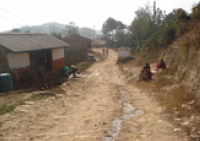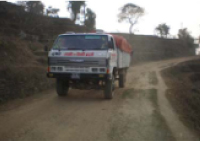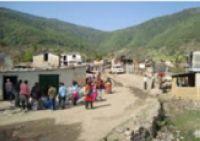


Client: DFID/Department of Local Infrastructure Development & Agricultural Roads
Funding Agency: Department for International Development
Period: August 2001 to October 2008
Consulting Association: WSP Imc, Helvetas Nepal, GEOCE Consultants (P) Ltd
Approx. Value of Services: GEOCE’s part- NRs 89.2 million
Professional Staff Input: International (132) and National (1380) person months. GEOCE’s part 894 person months
Salient Details
The Program (RAP) objective was to improve the livelihoods of the poor and disadvantaged in the 6 hill districts (Sangkhuwasabha, Bhojpur, Khotang, Achham, Dailekha and Doti) through the improvement of access to valued services and goods. The programme comprised construction of 90 km feeder and some 250 km of district roads (Bhojpur-Chyandanda, Bhojpur Airport-Bhojpur, Diktel-Chyandanda, Myaglung-Ishibu-Sankranti Bazar, Chainpur-Nundhaki and Bhyangkhola-Chhyankuti) and upgrading of trails and footbridges along these roads. To ensure a truly sustainable impact on the poor and disadvantaged, the building of rural roads in Nepal must be accompanied by a series of complementary interventions. ‘Improved Physical Access’ must lead to real improvements in rural access and contribute to livelihood sustainability, particularly where need is greatest. Hence RAP aimed to provide physical improvement (mainly roads), both for access by service providers and the poor and complementary activities to build capacity in response to local circumstances, needs and priorities. The Program cost was US$66 million.
Services were provided for surveys and studies, design, construction supervision, monitoring and evaluation to achieve physical rural access improvements together with policy development and social aspects through enhancing and protection interventions which form 20% of the project scope. The details of services included:
- Central Policy: investigation, development of rural access policy and support of GoN central policy unit.
- Lessons learning and information dissemination: – development of an information system, design and management of a national rural accessibility database and building of effective district communication.
- Accessibility planning: – introduction of the rural accessibility planning process through preparation of district transport master plans and development plans, establishment of funding mechanisms and maintenance systems for transport infrastructure and setting up community based audit systems.
- Construction of District and Feeder Roads: – engineering survey and design, IEE, land acquisition, formation and training of road construction groups and small contractors, establishment of implementation unit and programs, compensation and resettlement plan, bid documentation, civil works procurements, construction supervision of road construction, and social and environmental mitigation.
- Environmental and Social Development – preparation of briefs, appraisals and EIA, raising of awareness, definition of best practice, livelihood enhancement, decision making support and exit strategies to ensure sustainable development.
- Improving Rural Livelihoods: – establishment of enterprise roles, markets, partners, groups and facilitation of the provision of appropriate technical and business know-how and access to resources and assets.
- Overall program management elements
- Establishment and operation of a comprehensive monitoring and evaluation system.
